Runny nose and achy body. Cold, Flu, or COVID-19: Identifying Symptoms and Treatment Options
How can you differentiate between a common cold, influenza, and COVID-19. What are the key symptoms to look out for. When should you seek medical attention for respiratory illnesses. How can you effectively manage symptoms at home.
Understanding the Differences: Cold, Flu, and COVID-19
Respiratory illnesses can be challenging to distinguish, as they often share similar symptoms. However, recognizing the differences between the common cold, influenza (flu), and COVID-19 is crucial for proper treatment and preventing the spread of these contagious diseases.
Common Cold
The common cold is typically a mild illness caused by over 100 different viruses. It usually develops gradually and is characterized by the following symptoms:
- Runny or stuffy nose
- Sore throat
- Cough
- Sneezing
- Mild fatigue
- Slight body aches
- Low-grade fever (not always present)
Influenza (Flu)
Influenza is generally more severe than a cold and tends to come on suddenly. Common flu symptoms include:

- High fever (usually 100°F or higher)
- Severe body aches
- Extreme fatigue
- Dry cough
- Headache
- Chills
- Sore throat (less common)
COVID-19
COVID-19 symptoms can range from mild to severe and may appear 2-14 days after exposure to the virus. Common symptoms include:
- Fever or chills
- Cough
- Shortness of breath
- Fatigue
- Muscle or body aches
- Headache
- Loss of taste or smell
- Sore throat
- Congestion or runny nose
- Nausea or vomiting
- Diarrhea
Symptom Duration and Severity: What to Expect
Understanding the typical duration and severity of these illnesses can help in determining which one you might be experiencing:
Common Cold
Colds usually last for about 7-10 days. Symptoms are generally mild and improve gradually over time. Most people can continue their daily activities with minimal disruption.
Influenza
Flu symptoms often last for 5-7 days, but fatigue and weakness can persist for weeks. The illness tends to be more severe than a cold, often requiring bed rest and time off work or school.
COVID-19
The duration of COVID-19 symptoms can vary greatly, from a few days to several weeks or even months in some cases. Severity ranges from asymptomatic to life-threatening, with older adults and those with underlying health conditions at higher risk for severe illness.
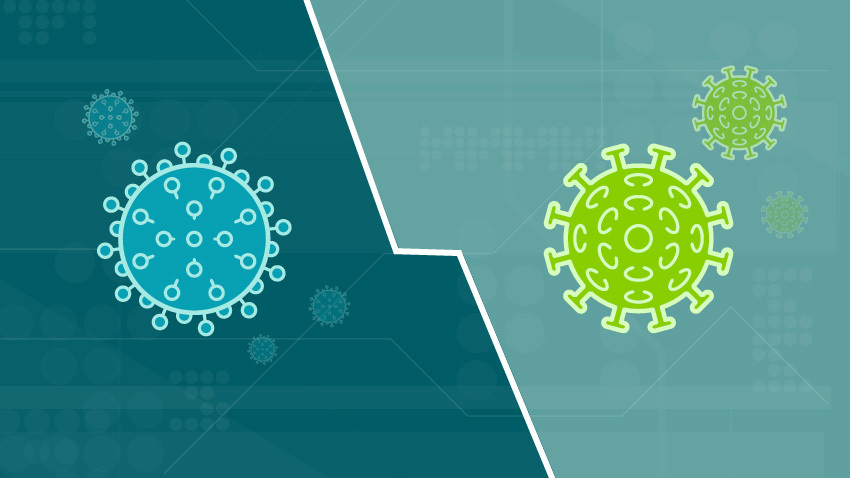
When to Seek Medical Attention
While many respiratory illnesses can be managed at home, certain symptoms warrant immediate medical attention. Contact your healthcare provider if you experience any of the following:
Emergency Symptoms in Children
- Fever above 102°F (38.9°C) or a fever lasting more than a few days
- Difficulty breathing or rapid breathing
- Bluish skin color
- Dehydration (not drinking enough fluids)
- Persistent ear pain or drainage
- Extreme irritability or confusion
- Symptoms that improve but then return with fever and worse cough
Emergency Symptoms in Adults
- Fever above 102°F (38.9°C) or a fever lasting more than a few days
- Difficulty breathing or shortness of breath
- Chest pain or pressure
- Fainting or feeling faint
- Confusion or disorientation
- Severe or persistent vomiting
- Severe sinus or facial pain
Home Treatment Strategies for Respiratory Illnesses
While there is no cure for viral respiratory illnesses, several strategies can help alleviate symptoms and promote recovery:
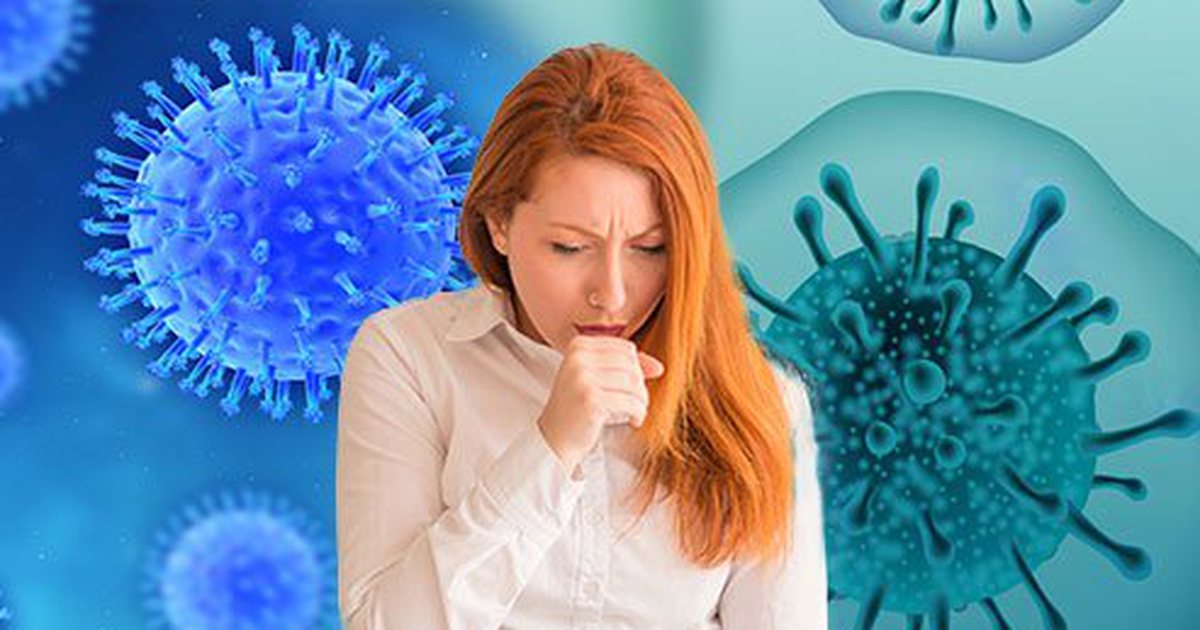
- Rest: Get plenty of sleep to help your body fight the infection.
- Hydration: Drink plenty of fluids, such as water, herbal tea, and clear broths.
- Humidification: Use a humidifier or take steamy showers to ease congestion.
- Salt water gargle: Gargle with warm salt water to soothe a sore throat.
- Over-the-counter medications: Use pain relievers, decongestants, and cough suppressants as needed (consult with a healthcare provider before giving medications to children).
- Nasal irrigation: Use a neti pot or saline nasal spray to clear congestion.
- Healthy diet: Consume nutrient-rich foods to support your immune system.
Prevention Strategies: Protecting Yourself and Others
Preventing the spread of respiratory illnesses is crucial for personal and public health. Implement these strategies to reduce your risk of infection and transmission:
- Practice good hand hygiene: Wash your hands frequently with soap and water for at least 20 seconds.
- Avoid touching your face: Keep your hands away from your eyes, nose, and mouth.
- Practice social distancing: Maintain at least 6 feet of distance from others, especially if you’re feeling unwell.
- Wear a mask: Use a face covering in public settings, particularly in areas with high transmission rates.
- Stay home when sick: Avoid going to work, school, or public places if you’re experiencing symptoms.
- Cover coughs and sneezes: Use a tissue or your elbow to cover your mouth and nose when coughing or sneezing.
- Clean and disinfect: Regularly clean and disinfect frequently touched surfaces in your home and workspace.
- Get vaccinated: Stay up to date with flu shots and COVID-19 vaccines as recommended by health authorities.
The Role of Vaccinations in Preventing Respiratory Illnesses
Vaccinations play a crucial role in preventing and reducing the severity of certain respiratory illnesses. Here’s what you need to know about available vaccines:
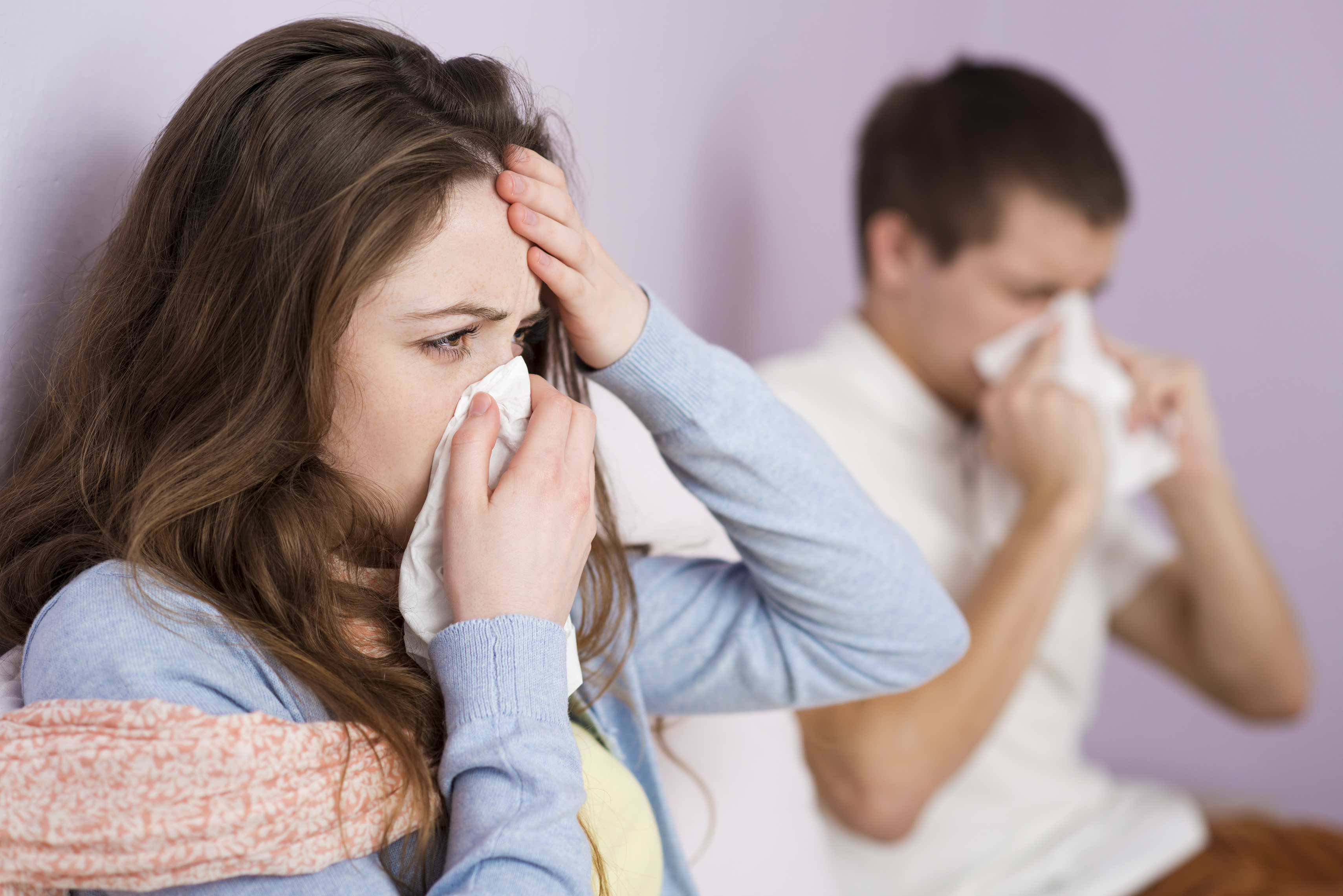
Influenza Vaccine
The flu vaccine is recommended annually for everyone 6 months and older, with rare exceptions. It’s particularly important for high-risk groups, including:
- Children between 6 months and 5 years old
- Adults over 50 years old
- Pregnant women
- People with chronic health conditions
- Healthcare workers
The best time to get vaccinated is before flu season begins, typically by the end of October. However, getting vaccinated later can still be beneficial.
COVID-19 Vaccine
COVID-19 vaccines are available and recommended for most individuals, with guidance varying by country and region. These vaccines have shown to be highly effective in preventing severe illness, hospitalization, and death from COVID-19.
Stay informed about the latest recommendations and booster shot guidelines from your local health authorities.
Respiratory Syncytial Virus (RSV): An Emerging Concern
In addition to colds, flu, and COVID-19, Respiratory Syncytial Virus (RSV) has become increasingly prevalent. RSV is a common respiratory virus that usually causes mild, cold-like symptoms but can be serious, especially for infants and older adults.

RSV Symptoms
Common symptoms of RSV include:
- Runny nose
- Decrease in appetite
- Coughing
- Sneezing
- Fever
- Wheezing
In very young infants, irritability, decreased activity, and breathing difficulties may be the only symptoms of RSV.
RSV Treatment
Most RSV infections go away on their own in a week or two. There is no specific treatment for RSV infection, though researchers are working to develop vaccines and antivirals. Management of RSV usually involves treating the symptoms, which may include:
- Over-the-counter fever reducers and pain relievers
- Plenty of fluids to prevent dehydration
- Nasal saline drops and suctioning for congestion
- Cool-mist humidifier to ease coughing and congestion
For severe cases, especially in high-risk individuals, hospitalization may be necessary for supportive care, such as oxygen therapy or IV fluids.
Long-Term Effects of Respiratory Illnesses
While most people recover fully from respiratory illnesses within a few weeks, some may experience long-term effects, particularly with COVID-19. Understanding these potential long-term impacts is crucial for proper care and management.

Post-COVID Conditions (Long COVID)
Some people who have been infected with COVID-19 experience a range of new, returning, or ongoing health problems for weeks or months after first being infected. This condition is known as “long COVID” or “post-COVID conditions.” Symptoms may include:
- Fatigue
- Difficulty thinking or concentrating (“brain fog”)
- Shortness of breath
- Headache
- Dizziness upon standing
- Heart palpitations
- Chest pain
- Joint or muscle pain
- Depression or anxiety
- Changes in smell or taste
If you’re experiencing persistent symptoms after a COVID-19 infection, consult with your healthcare provider for appropriate evaluation and management.
Post-Viral Syndrome
Some individuals may develop post-viral syndrome following other respiratory infections, including influenza. Symptoms can include:
- Chronic fatigue
- Weakness
- Depression
- Sleep disturbances
- Muscle and joint pain
While post-viral syndrome typically resolves on its own over time, managing symptoms and maintaining a healthy lifestyle can aid recovery.

The Importance of Mental Health During Respiratory Illnesses
Dealing with respiratory illnesses, especially during a pandemic, can take a toll on mental health. It’s crucial to address both physical and psychological well-being during these times.
Coping Strategies
Consider implementing these strategies to maintain good mental health:
- Stay connected: Maintain social connections through phone calls, video chats, or safe in-person interactions.
- Practice mindfulness: Engage in meditation, deep breathing exercises, or yoga to reduce stress and anxiety.
- Maintain a routine: Establish a daily schedule to provide structure and normalcy.
- Limit media consumption: Stay informed but avoid excessive exposure to news that may increase anxiety.
- Engage in hobbies: Pursue activities you enjoy to boost mood and reduce stress.
- Seek professional help: Don’t hesitate to reach out to a mental health professional if you’re struggling to cope.
Supporting Others
If you know someone dealing with a respiratory illness, consider these ways to offer support:

- Check in regularly: Offer emotional support through calls, texts, or video chats.
- Provide practical assistance: Offer to run errands, deliver groceries, or help with household tasks.
- Listen without judgment: Allow them to express their feelings and concerns openly.
- Encourage self-care: Remind them to prioritize their physical and mental health.
- Share reliable information: Help them access accurate and up-to-date health information from reputable sources.
By understanding the differences between common respiratory illnesses, knowing when to seek medical attention, and implementing effective prevention and treatment strategies, you can better manage your health and well-being. Remember to stay informed, practice good hygiene, and prioritize both your physical and mental health during these challenging times.
Colds and the Flu: Tips for Feeling Better
Am Fam Physician. 2006;74(7):1179-1180
How can I tell if I have a cold or the flu?
Colds and the flu cause many of the same symptoms. But colds are usually mild, while the flu tends to be more severe.
A cold often starts with feeling tired, sneezing, coughing, and having a runny nose. You may not have a fever, or you may run a low fever—just 1 or 2 degrees higher than usual. You may have muscle aches, a scratchy or sore throat, watery eyes, and a headache.
The flu starts suddenly and hits hard. You will probably feel weak and tired and have a fever, dry cough, a runny nose, chills, muscle aches, a bad headache, eye pain, and a sore throat. It usually takes longer to get over the flu than a cold.
It usually takes longer to get over the flu than a cold.
What causes colds and the flu?
More than 100 different viruses can cause colds. There aren’t as many viruses that cause the flu. That’s why there is a shot for the flu and not for colds. To keep from getting the flu, all children between six months and five years of age, adults older than 50 years, and people with asthma or lung problems should get a flu shot every October or November.
What can I do to feel better?
There is no cure for a cold or the flu. Antibiotics don’t work against viruses. Unless you have the flu and see your doctor within two days after your symptoms start, all you can do to feel better is treat your symptoms while your body fights off the virus. You can also use over-the-counter cold medicines to help you feel better. Do not give children cold medicine without checking with your doctor first. People who take prescription medicine also should check with their doctor before taking over-the-counter cold medicine.
Ways to treat your cold and flu symptoms
Stay home and rest, especially while you have a fever.
Stop smoking, and avoid secondhand smoke.
Drink plenty of fluids like water, fruit juices, and clear soups.
Do not drink alcohol.
Gargle with warm salt water a few times a day if you have a sore throat. Throat sprays or lozenges may also help with the pain.
Use a nose spray to help loosen mucus and moisten the skin in your nose.
Should I call my doctor?
Most people do not need to see a doctor when they have a cold or the flu. But if you have any of the symptoms in the box below, call your doctor.
Emergency cold and flu symptoms
In children:
Fever above 102°F (38.9°C) or a fever that lasts a long time
A cold that lasts for more than 10 days
Trouble breathing, fast breathing, or wheezing
Bluish skin
Not drinking enough fluids
Earache or drainage from the ear
Mental changes (such as trouble waking up, irritability, or seizures)
Flu-like symptoms that get better but come back later with a fever and a worse cough
Chronic medical problems (such as diabetes or heart disease) that get worse
In adults:
Fever above 102°F (38.
 9°C) or a fever that lasts a long time
9°C) or a fever that lasts a long timeA cold that lasts for more than 10 days
Trouble breathing or shortness of breath
Pain or pressure in the chest
Fainting or feeling like you are about to faint
Confusion
Severe vomiting
Very bad pain in your face or forehead
Hoarseness, sore throat, or a cough that won’t go away
Cold, flu, or COVID-19: Which one is it?
Coughing? Fever? Chills? How can you tell if you have a cold, influenza, or COVID-19? Here’s how they compare.
Not just colds, the flu and COVID-19
PeaceHealth providers are seeing a lot more patients with Respiratory Syncytial Virus (RSV). Learn more about RSV symptoms and treatment.
How can you tell if you have a cold, influenza, or COVID-19? Understanding the differences in symptoms that these illnesses cause will help.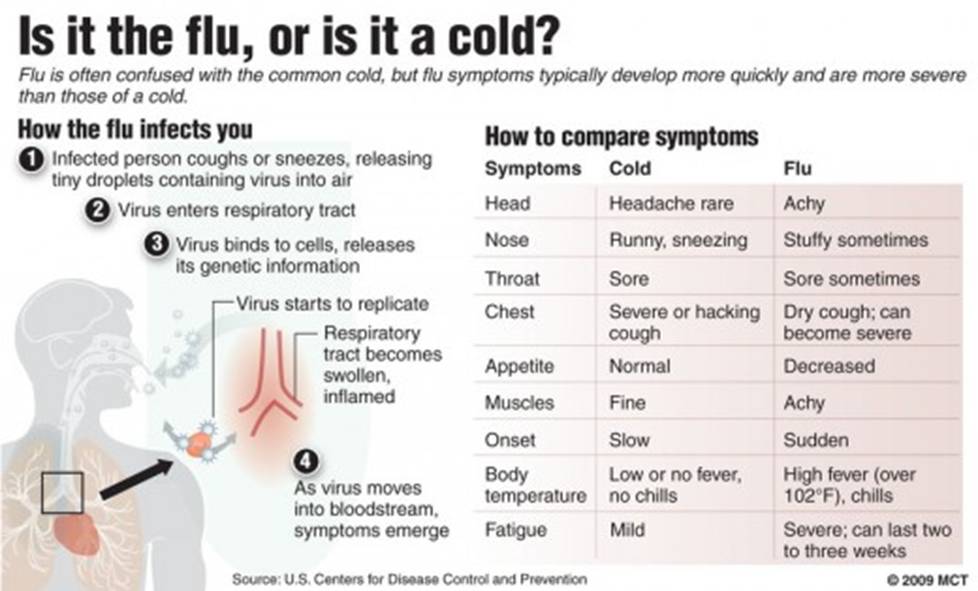
Common colds, influenza (flu), and COVID-19 are contagious respiratory illnesses caused by different viruses. Many symptoms of the three are similar, which can cause confusion about which one you may be suffering from. Contact your primary care provider to determine what care you may need, including testing to determine which, if any, virus you have.
How the three illnesses compare
COVID-19 is a highly contagious respiratory illness. COVID-19 can have varying degrees of symptoms, from none to severe. Symptoms may include fever or chills, cough, sore throat, and the loss of taste or smell. COVID-19 can cause medical complications, especially in higher-risk groups, and can result in hospitalization and death. Severe illness, such as lung injury, is more frequent with COVID-19 than with influenza. The mortality rate also is higher with COVID-19 than with the flu.
Influenza is a contagious respiratory illness that can cause mild to severe symptoms such as fever, cough, and body aches. A bad headache and fatigue—which can linger for weeks after your initial illness has passed—are hallmarks of the flu. Most people with the flu don’t need medical care or medication. However, the flu can be very serious and require medical attention. Contact your doctor if your symptoms worsen, are prolonged, or if you’re at high risk of flu-related complications.
A bad headache and fatigue—which can linger for weeks after your initial illness has passed—are hallmarks of the flu. Most people with the flu don’t need medical care or medication. However, the flu can be very serious and require medical attention. Contact your doctor if your symptoms worsen, are prolonged, or if you’re at high risk of flu-related complications.
You may feel pretty crummy with a common cold, but the symptoms are mild compared to viruses like the flu and COVID-19. Cold symptoms typically progress over seven to 10 days in this order: Sore throat, congestion, cough. Sniffling and sneezing are classic cold symptoms, and it’s more common to experience a stuffy or runny nose with a cold than the flu. Rest and many over-the-counter medications can help relieve symptoms.
Symptoms are increasingly similar
The latest update from the Zoe Health Study, a COVID-19 symptom tracker devised by researchers at Harvard, Stanford and King’s College in London, shows that COVID-19 symptoms are looking more and more like those of the flu, colds and even allergies, especially among the vaccinated.
Doctors noticed that as the omicron variant became predominant, patients experienced more upper respiratory symptoms than earlier variants. Because initial symptoms are now “influenza-like,” you may need to see a doctor for testing to determine which virus you have.
The new ranking of symptoms for people who have received at least two doses of vaccine is:
- Sore throat
- Runny nose
- Blocked nose
- Persistent cough
- Headache
Reports of sneezing as a COVID-19 symptom emerged from people who’d had at least one dose of the vaccine. But sneezing was not widely reported by those who have remained unvaccinated; instead, they reported more often experiencing fever. The new ranking for the unvaccinated is:
- Headache
- Sore throat
- Runny nose
- Fever
- Persistent cough
It typically takes longer for someone to experience symptoms of COVID-19 than if they have the flu. COVID-19 symptoms generally appear two to five days after infection but could be as long as 14 days later. In contrast, flu symptoms usually appear about one to four days after infection. It’s possible to be infected with the virus that causes COVID-19 or the flu without experiencing symptoms. Common cold symptoms usually appear one to three days after exposure to a cold-causing virus.
COVID-19 symptoms generally appear two to five days after infection but could be as long as 14 days later. In contrast, flu symptoms usually appear about one to four days after infection. It’s possible to be infected with the virus that causes COVID-19 or the flu without experiencing symptoms. Common cold symptoms usually appear one to three days after exposure to a cold-causing virus.
Differences in COVID-19 and influenza symptoms
So far, research indicates that a change in or the loss of taste and smell may be the only significant difference in symptoms between COVID-19 and the flu. Some people with the flu may also experience a loss of taste or smell, but it is less frequent. Because of this, you may need to see a doctor for testing to determine which virus you have.
There are a few other notable similarities and differences between influenza and COVID-19.
How the viruses spread:
- Similarities: COVID-19 and the flu can spread from person-to-person when they’re within about 6 feet.
 Both are spread mainly by respiratory droplets when someone coughs, sneezes or talks. People may spread both before they begin showing symptoms, by people with very mild symptoms, and by people who never develop symptoms (asymptomatic).
Both are spread mainly by respiratory droplets when someone coughs, sneezes or talks. People may spread both before they begin showing symptoms, by people with very mild symptoms, and by people who never develop symptoms (asymptomatic). - Differences: Although they spread similarly, COVID-19 is generally more contagious and appears to spread more quickly and easily than the flu. COVID-19 can spread to others by people before they begin showing symptoms, by people with very mild symptoms, and by people who never develop symptoms (asymptomatic).
People at higher risk for severe illness:
- Similarities: Both viruses can cause severe illness in older adults, people with certain underlying medical conditions, and pregnant people.
- Differences: Overall, COVID-19 seems to cause more severe illness in people. Some groups of people are at a higher risk for COVID-19 than others.
Complications:
- Similarities: Both COVID-19 and the flu can cause these complications:
- Pneumonia
- Respiratory failure
- Acute respiratory distress syndrome (fluid in the lungs)
- Sepsis (a life-threatening illness caused by the body’s extreme response to an infection)
- Cardiac injury (heart attacks and stroke)
- Multiple-organ failure (respiratory failure, kidney failure, shock)
- Worsening of chronic conditions (involving the lungs, heart, or nervous system or diabetes)
- Inflammation of the heart, brain, or muscle tissues
- Secondary bacterial infections (infections in people who have already had the flu or COVID-19)
- Differences: COVID-19 can also cause blood clots in the lungs, heart, legs or brain and cause Multisystem Inflammatory Syndrome in Children (MIS-C) and Adults (MIS-A).

Anyone who has had COVID-19, even if their illness was mild or had no symptoms, can experience post-COVID conditions, also known as Long COVID. Post-COVID conditions are a range of symptoms that can last weeks or months after being infected with the virus that causes COVID-19 or can appear weeks after infection.
Many people with the flu or mild symptoms of COVID-19 can recover at home with rest and fluids. But some people become seriously ill from the flu or COVID-19 and must stay in the hospital.
Prevention
Stay up-to-date on your COVID-19 vaccinations and get an annual flu vaccine. Following several standard precautions can reduce your risk of infection from the viruses that cause COVID-19, colds, and the flu.
- Avoiding close contact (within 6 feet) with people who are sick.
- Self-quarantining when symptomatic.
- Wearing a face mask in indoor public spaces and outdoors, such as at a crowded event or large gathering.
- Avoiding crowded indoor spaces.

- Covering your mouth and nose with your elbow or a tissue when you cough or sneeze.
- Avoiding touching your eyes, nose, and mouth.
- Washing hands often with soap and water for at least 20 seconds.
- Cleaning and disinfecting high-touch surfaces and objects.
Treatments
There’s no cure for the common cold. Treatment may include pain relievers and over-the-counter cold remedies, such as decongestants. Most people recover from a common cold in three to 10 days, although some colds may last as long as two or three weeks.
Like the cold, there are many over-the-counter remedies available. Getting an annual flu vaccine will reduce the severity of the flu and the risk of serious complications if you get sick. The vaccine is recommended for everyone six months or older and can be given as a shot or a nasal spray. In more severe cases, several antiviral drugs may be prescribed by a physician. Treatments can make the illness milder and shorten the time you are sick.
Unlike the common cold and the flu, there are only a few approved medications to treat COVID-19. Most people with COVID-19 have mild illnesses and can recover at home. You can treat symptoms with over-the-counter medicines, such as acetaminophen (Tylenol) or ibuprofen (Motrin, Advil), to help you feel better. Like the flu vaccine, staying up-to-date on your COVID-19 vaccination can also reduce the severity of COVID-19 and the risk of serious complications.
The FDA has authorized certain antiviral medications to treat mild to moderate COVID-19 in people who are more likely to get very sick. Paxlovid and Molnuoiravir are oral medications that need to be started within five days of when symptoms start.
If you have symptoms of the flu or COVID-19, contact your primary care provider to determine what care you may need, including testing to determine which, if any, virus you have.
COVID-19 and flu vaccines are widely available at many community locations, including drug stores and pharmacies. Visit vaccines.gov to find a location near you.
Visit vaccines.gov to find a location near you.
Source: Centers for Disease Control and Prevention
How to distinguish the flu from a cold
The common cold is often confused with the flu, mistakenly taking one for the other. Learn to discern to avoid complications.
Acute respiratory tract infections (ARVI), commonly referred to as the common word “cold”, are caused by a huge number of viruses and account for approximately three-quarters of all infectious diseases on the planet.
How is SARS transmitted?
They are transmitted mainly by airborne droplets, that is, through the air along with the sputum of a sick person when he sneezes or coughs.
Flu epidemic
Viruses cause inflammation of the mucous membrane of the nasal cavity, nasopharynx, throat, trachea and bronchi.![]()
SARS is not the flu
The common cold is often confused with the flu, mistaking one for the other. It should be remembered that ARVI is a more harmless disease that usually passes quickly, is easily cured and rarely gives complications.
The illness caused by the influenza virus is more severe and can lead to complications such as pneumonia.
Most important flu symptoms
Call a doctor urgently if you or your family have these symptoms:
– a sharp increase in temperature to 39-40 degrees,
– severe muscle pain (“body aches”),
– dry and painful cough in the absence of a runny nose,
– severe weakness.
What if SARS?
Slightly elevated temperature, sore throat and runny nose? These are typical symptoms of SARS. This disease is treated quite simply.
This disease is treated quite simply.
Unfortunately, it is customary to either “walk” a cold on one’s feet, or kill it with a set of cough tablets, antibiotics, and cold drops taken at the same time. Without calling a doctor.
Important! Antibiotics do not treat SARS or flu! They are used only as directed by a doctor in the event that diseases cause complications.
Take your time with your medications
Nose drops are no easier to choose from. Almost all drugs offered on the market include vasoconstrictors that allow you to remove the swelling of the mucous membrane and save a person from a “clogged” nose.
These drugs are contraindicated in children under six years of age, pregnant and lactating women, and older people, since the vasoconstrictor components can cause an increase in blood pressure and an increase in heart rate.
That is why even with a “banal” runny nose, medicines should be selected by a doctor. He can professionally evaluate individual indications and contraindications.
Is it necessary to lower the temperature?
The recommendations of the World Health Organization say that the temperature should not be brought down below 38. 5 degrees.
5 degrees.
This temperature is a protective reaction of the body to the invasion of infection. After all, bacteria and viruses reproduce equally poorly both in the cold and at elevated temperatures.
In addition, a high temperature is a sign that the infection still exists in the body and needs to be fought.
Who needs to bring down the temperature?
Bringing down the temperature is necessary:
– for children and adults with heart disease (angina pectoris, coronary heart disease, heart defects),
– for those suffering from chronic bronchitis, obstructive pulmonary disease, asthma,
– for people with diseases of the central nervous systems, for example suffering from epilepsy.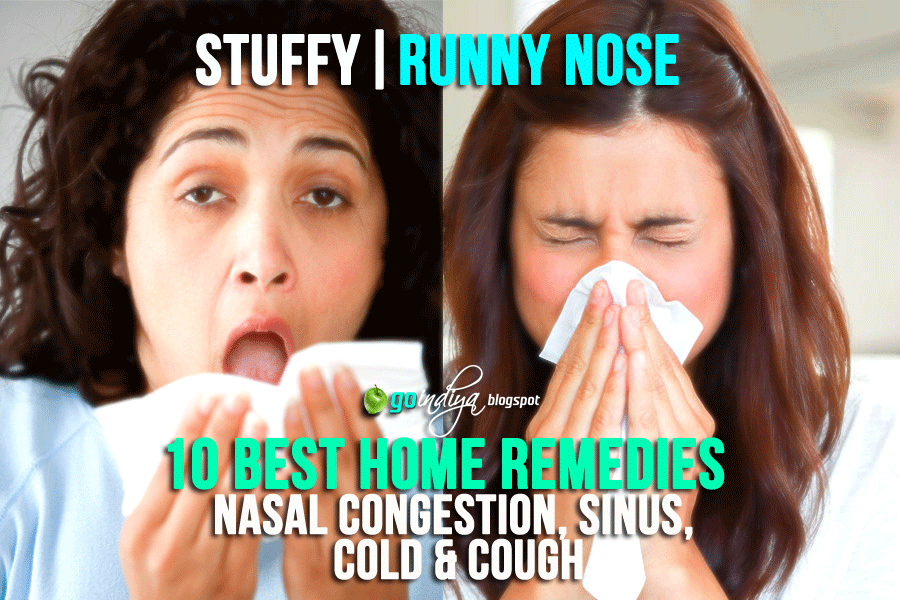
Important! Temperature is always a reason to see a doctor.
Help yourself
– Don’t be a hero. At the first sign of SARS, refuse to go to work and stay at home. Lie down more, try not to read or watch TV. Postpone the solution of work issues by phone. Allow yourself to get sick, and the immune system not to be distracted by other tasks, except for healing.
– Drink more. A healthy body needs at least one and a half liters of water per day. With illness, the need for fluid increases. Try to drink warm drinks and avoid alcohol. Alcohol does not cure a cold, but, on the contrary, lowers the body’s defenses. An attempt to cure with “vodka with pepper” can lead to a delay in the healing process.
– Don’t overeat. Appetite for ARVI is usually reduced, but relatives and friends sometimes try to please the patient with various delicacies. Digesting a large amount of fatty or sweet foods is an additional burden on the body.
why there is pain with colds, flu and SARS
06/01/2022
3 minutes
105 655
Contents
- Body aches: when it appears and why
- Muscle pain with influenza and SARS
- Other causes of muscle pain
- How to remove pain in the joints and muscles with a cold?
- Additional tips
During illness, many feel overwhelmed, there is weakness, pain in the muscles, joints and back. Unpleasant sensations can be disturbing during the flu and the common cold. Next, we will talk in detail about the causes of discomfort and how to remove the symptoms.
Unpleasant sensations can be disturbing during the flu and the common cold. Next, we will talk in detail about the causes of discomfort and how to remove the symptoms.
Body aches: when it appears and why
Body aches are pain in the muscles, back and joints. It often appears along with general weakness and a feeling of malaise.
Muscle pain with influenza and SARS
Soreness in the body is a common symptom of viral and bacterial infections¹. Aches in the body are often accompanied by a high temperature with SARS and influenza. But it can be expressed in different ways (it all depends on the “culprit” of the disease):
- With ARVI , pain occurs less frequently. The sick person is more concerned about discomfort in the throat, runny nose, a slight increase in temperature (usually within 37–38 ° C)⁴.
- With influenza , muscle pain is much more common and is considered one of the key symptoms.
 It is joined by: weakness, headache, unpleasant sore throat, cough³. At the same time, the temperature can be quite high: more than 38 ° C.
It is joined by: weakness, headache, unpleasant sore throat, cough³. At the same time, the temperature can be quite high: more than 38 ° C.
Muscle pain in ARVI and influenza is a symptom of body intoxication. It is provoked by toxic substances that are formed during the infectious process in the body. They enter the blood and quickly spread throughout all body systems, accumulate in the muscles². That is why you could notice: the higher the temperature, the more the whole body hurts⁶.
With influenza, such a reaction can last about 5 days, and during SARS – up to 12 days⁴. Then the temperature gradually decreases, and with it the discomfort disappears.
Other causes of muscle pain
Sometimes muscle discomfort is a normal reaction of the body to unusual physical activities. For example, if you decide to go jogging or return to the gym after a long break. Sometimes muscle pain can disturb absolutely healthy people after a long stay in the cold or in an uncomfortable position due to stressful situations.
Sometimes muscle pain can disturb absolutely healthy people after a long stay in the cold or in an uncomfortable position due to stressful situations.
Other causes of body aches to be aware of:
allergies;
diabetes;
neuroses;
blood diseases;
neoplasms;
chronic bowel disease;
impaired metabolism.
To get rid of pain, you need to remove its cause. That is why it is important to consult a doctor at the first symptoms of malaise.
How to remove pain in joints and muscles with a cold?
For mild or moderate muscle and joint pain, doctors recommend the use of drugs with paracetamol. They have a double effect: they anesthetize and lower the temperature. Paracetamol is considered safe for the treatment of fever in children and adults⁵.
Coldrex is a complex remedy with paracetamol that can be used to combat common symptoms of SARS and flu.
The warming drink is suitable for adults and children from 6 years old⁷. It helps to eliminate the unpleasant symptoms of a cold and maintain the natural fluid balance in the body. An additional plus – Coldrex does not provoke drowsiness.
It helps to eliminate the unpleasant symptoms of a cold and maintain the natural fluid balance in the body. An additional plus – Coldrex does not provoke drowsiness.
Active ingredients:
- Paracetamol reduces fever and helps with headache, joint and muscle pain.
- Phenylephrine reduces swelling of the nasal mucosa and facilitates nasal breathing.
- Vitamin C fills the increased need for it in case of “cold” diseases and flu.
Choose your Coldrex
Additional Tips
To eliminate unpleasant symptoms, such as pain in the joints and muscles, and improve well-being during illness, you can use simple recommendations:
Drink plenty of water. The greater the intoxication of the body, the worse the state of health. Therefore, a sufficient amount of liquid is needed to quickly remove toxins from the body. The best option is water without gas and drinks that do not contain sugar (unsweetened compotes, herbal tea).
The greater the intoxication of the body, the worse the state of health. Therefore, a sufficient amount of liquid is needed to quickly remove toxins from the body. The best option is water without gas and drinks that do not contain sugar (unsweetened compotes, herbal tea).
Fresh air. In the room where a person is during an illness, the level of carbon dioxide in the air gradually increases. This can result in headache, increased drowsiness and irritability. As a result, the body needs to expend extra energy to get the oxygen it needs. For this reason, you need to regularly ventilate the room, regardless of the season.
Proper nutrition. During the period of illness, our body spends a lot of energy fighting bacteria or a virus. That is why you should not overload the digestive system – before recovery, it is better to exclude rich meat broths, strong coffee, chocolate, spicy, fried and canned foods, fast food. Choose foods that are easy and quick to digest: fresh vegetables and fruits, yogurt, kefir, eggs, lean meats.
Important! To help the immune system during colds and flu, it is useful to consume foods high in vitamin C: rose hips, cranberries, lemons and other citrus fruits.
SARS and influenza are often named among the main causes of body aches. But do not rush to make a diagnosis yourself. To quickly eliminate symptoms, it is important to consult a doctor and accurately determine the cause of the pain. Only a specialist will prescribe appropriate tests and effective treatment.
Tags
Symptoms
Treatment for adults
References
- Shikh E.V./Vitamins with antioxidant properties in the prevention and treatment of acute respiratory infections in children/ Issues of modern pediatrics. 2013;12(4):142-147/
- Instructions for Coldrex preparations – official website of Coldrex
Useful information
Coldrex against colds
No one expects a cold “to visit”: it always comes unexpectedly and can easily disrupt your plans.
Learn more
Colds: signs, symptoms and treatment
The unpleasant symptoms of a cold are familiar to everyone: nasal congestion, “itchy” throat and feeling of weakness. They can easily spoil the mood and change important plans.
Learn more
Prevention of colds, flu and ARVI
Acute respiratory viral infections (ARVI) or the common cold, as we used to call them, are the most common diseases in our country.
Learn more
What to do at the first sign of a cold
Traditionally, a cold is an acute respiratory viral infection (ARVI), which has a mild course, often associated with the general hypothermia of the body.
Learn more
Colds without fever
The onset of the cold season means the arrival of the season of colds.
Learn more
Influenza: signs, symptoms and treatment
Influenza is an acute respiratory illness that can affect the upper and lower respiratory tract.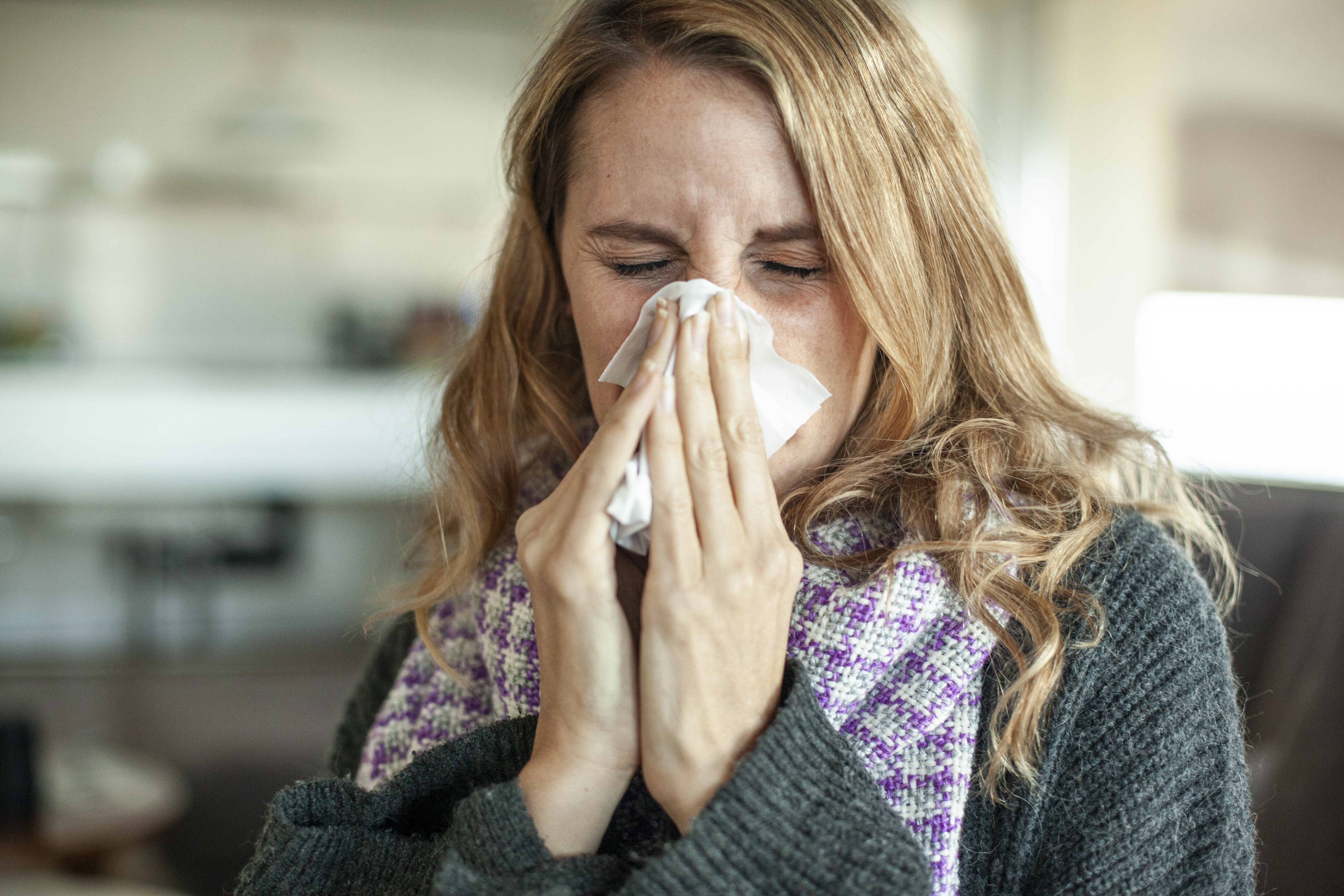

 9°C) or a fever that lasts a long time
9°C) or a fever that lasts a long time Both are spread mainly by respiratory droplets when someone coughs, sneezes or talks. People may spread both before they begin showing symptoms, by people with very mild symptoms, and by people who never develop symptoms (asymptomatic).
Both are spread mainly by respiratory droplets when someone coughs, sneezes or talks. People may spread both before they begin showing symptoms, by people with very mild symptoms, and by people who never develop symptoms (asymptomatic).

 It is joined by: weakness, headache, unpleasant sore throat, cough³. At the same time, the temperature can be quite high: more than 38 ° C.
It is joined by: weakness, headache, unpleasant sore throat, cough³. At the same time, the temperature can be quite high: more than 38 ° C.